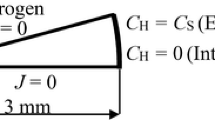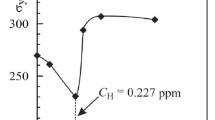Abstract
We propose a new procedure for investigation of hydrogen embrittlement of steels. It is based on the use of a physically grounded quantitative criterion for reversible influence of hydrogen. This criterion is determined from the ratio between values of the actual fracture stress for a metal in hydrogenated and initial states. The procedure involves the use of standard cylindrical specimens, which are deformed by uniaxial tension in a prescribed temperature range. To illustrate the potentials of the new procedure, experimental results for hydrogen embrittlement of 09G2S steel are presented.
Similar content being viewed by others
References
B. A. Kolachev,Hydrogen Brittleness of Metals [in Russian], Metallurgiya, Moscow (1995).
V. V. Panasyuk, S. E. Kovchik, and G. I. Smoroda, “Methods of estimation of hydrogen brittleness of structural materials,”Fiz.-Khim. Mekh. Mater. 15, No. 3, 5–17 (1979).
G. V. Karpenko and R. I. Kripyakevich,Influence of Hydrogen on Steel Properties [in Russian], Metallurgizdat, Moscow (1962).
S. A. Golovanenko, L. V. Popova, V. N. Zikeev, et al., “Connection between the tendency to embrittlement by hydrogen sulfide and the mechanical properties of 09G2 steel on various variants of alloying,”Probl. Prochn., No. 10, 57–61 (1978).
G. Irzhov, S. A. Golovanenko, and T. K. Sergeeva, “Resistance to hydrogen embrittlement of steels for main pipelines,”Fiz.-Khim. Mekh. Mater.,18, No. 3, 89–93 (1982).
L. I. Gribanova, V. I. Sarrak, G. A. Filippov, and A. M. Shlyafimer, “Influence of microplastic strain on the behavior of hydrogen in steel and resistance to hydrogen brittleness,”Fiz.-Khim. Mekh. Mater.,17, No. 5, 29–33 (1981).
V. I. Malkin, “Rapid method for estimation of the tendency of steel to hydrogen embrittlement,”Zavod. Lab., No. 3, 66–67 (1984).
V. I. Malkin, N. P. Talov, and I. V. Vaganova, “Hydrogen embrittlement of corrosion-resistant ferritic steels depending on their chemical composition and heat treatment,”Fiz.-Khim. Mekh. Mater.,21, No. 4, 103–104 (1985).
A. F. Svetlichkin and G. F. Raizman, “Degree of shear deformation as a parameter of steel embrittlement in moist hydrogen sulfide,”Fiz.-Khim. Mekh. Mater.,18, No. 5, 107–108 (1982).
O. N. Romaniv, G. N. Nikiforchin, and A. S. Krys'kiv, “Applicability of the criteria of fracture mechanics for estimation of hydrogen brittleness of high-strength steels,”Fiz.-Khim. Mekh. Mater.,16, No. 6, 54–60 (1980).
I. K. Pokhodnya, V. I. Shvachko, V. N. Upyr', et al., “On a mechanism of the influence of hydrogen on brittleness of metals,”Dokl. Akad. Nauk SSSR,308, No. 5, 1131–1134 (1989).
I. K. Pokhodnya, V. I. Shvachko, S. A. Kotrechko, et al., “Influence of hydrogen on brittleness of structural steels and welded joints,”Avtomat. Svarka, No. 5, 1–4 (1989).
Yu. Ya. Meshkov and G. A. Pakharenko,Metal Structure and Brittleness of Steel Constructions [in Russian], Naukova Dumka, Kiev (1989).
Yu. Ya. Meshkov and T. N. Serditova,Fracture of Deformed Steel [in Russian], Naukova Dumka, Kiev (1989).
P. W. Bridgman,Studies in Large Plastic Flow and Fracture with Special Emphasis on the Effects of Hydrostatic Pressure, New York (1952).
L. A. Kopel'man,Resistance of Welded Assemblies to Brittle Fracture [in Russian], Mashinostroenie, Leningrad (1978).
I. K. Pokhodnya, Yu. Ya. Meshkov, V. I. Shvachko, et al.,A Method for Quantitative Determination of the Degree of Hydrogen Embrittlement of Structural Steels and Welds, Application No. 5040067, MKI G 01 n 17/00 of 01.07.91, Positive Decision of the Russian Patent Dept. of 28.09.92.
Additional information
Paton Institute of Electric Welding, Ukrainian Academy of Sciences, Kiev. Translated from Fizyko-Khimichna Mekhanika Materialiv, Vol. 34, No. 4, pp. 79–84, July–August, 1998.
Rights and permissions
About this article
Cite this article
Pokhodnya, I.K., Shvachko, V.I., Kotrechko, S.A. et al. A new method for quantitative determination of sensitivity of steels to hydrogen embrittlement. Mater Sci 34, 538–543 (1998). https://doi.org/10.1007/BF02360706
Received:
Issue Date:
DOI: https://doi.org/10.1007/BF02360706




